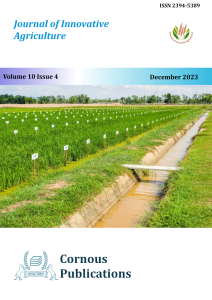
Journal of Innovative Agriculture
Peer Reviewed Open Access Journal
ISSN: 2394-5389 NAAS Rate: 4.05
Submit Manuscript
Peer Reviewed Open Access Journal
ISSN: 2394-5389 NAAS Rate: 4.05
Submit ManuscriptThe study was conducted to identify agro-pastoralist traits preferences, constraints and perceptions of Boer woyto-guji crossbreed kids born with buck mobilization project at Hammer District, South Omo zone. A total of fifteen projects benefited participants through buck mobilization and experience in goat rearing were involved of which 86.7% and 13.3% were male and female participants, respectively. Information on traits preferred, goat husbandry management, and breeding practices perceived by agro-pastoral communities was collected using a questionnaire and data was analyzed using descriptive statistics. In two phases the fifteen participants contributed 92 dry local females with an average of 6.13 (ranging from 4 to 12). From the contributed 68 (74%) goats served and only 55(60%) were tested positive for pregnancy due to different reasons. The agro-pastoralist preferences of the crossbreed kids were assessed and their responses were collected by interviewing. About 66.7%, 86.7%, and 93.3% of them asserted that cross kids were below their local goats on disease resistance, feed shortage, and water shortage tolerance, respectively. Results revealed that quantitative yield traits, phenotypic appearance, and temperament of the crossbreeds were accepted (100%) with a very good preference rate. The participants were asked to mention their preference for crossbreed with their drawbacks and cited fast growth, color, ear and horn type, good conformation or body size of the kids were good traits while docile behavior which can predispose to predators, high feed consumption, low resistance of disease, water and feed shortage as weak traits. From the questionnaire, the pastorals replied that the crossbreed kids live with other local kids together (100%) in the barn. The most important challenges mentioned and perceived by the pastorals in the buck mobilization were improper selection of breeding doe which led to abortion or stillbirth of doe, dystocia, death of crossbreed kids, eaten by predators in pastures, short duration of the buck with doe’s and false mating of doe. Lack of training and awareness creation, diseases, and poor extension linkage are also cited as constraints. It is concluded that, to overcome the identified constraints it needs appropriate strategies on various interventions such as provision of theoretical and practical ongoing training, utilization of buck mobilization program through the formation of cooperation and use of production packages for the implementation and sustainable utilization of improved breeds.
Agro-pastoralists, trait preferences, buck mobilization, constraints, crossbreed goats
Alemayehu, M., & Tezera, G. (2002). Socio-economic of pastoral Community in Bena-Tsemay and Hamer Woredas of South Omo Zone. Southern Nations and Nationalities peoples Regional State, Ethiopia.
Ayalew, W., Rischkowsky, B., King, J. M., & Bruns, E. (2003). Crossbreds did not generate more net benefits than indigenous goats in Ethiopian smallholdings. Agricultural systems, 76(3), 1137-1156.
Baker, R. L., & Gray, G. D. (2004). Appropriate breeds and breeding schemes for sheep and goats in the tropics. In Worm Control for Small Ruminants in Tropical Asia (ACIAR Monograph No. 113, pp. 63-96). Canberra, Australia: ACIAR.
Berhanu, T., Thiengtham, J., Tudsri, S., Abebe, G., Tera, A., & Prasanpanich, S. (2012). Purposes of keeping goats, breed preferences and selection criteria in pastoral and agro-pastoral districts of South Omo Zone. Livestock Research for Rural Development, 24(12), Article 20.
Ethiopia Sheep and Goat Productivity Improvement Program. (2009). Goat breeds of Ethiopia: A guide for identification and utilization (Technical Bulletin No. 27). Addis Ababa, Ethiopia: ESGPIP.
Farm-Africa (1996). Goat types of Ethiopia and Eritrea. Physical description and management systems. Published jointly by FARM-Africa and International Livestock Research Institute.
Getaneh, D. (2023). Assessment of dairy production system, handling, processing and utilization practices in South Ari and Malle district of South Omo zone, Ethiopia. Research on World Agricultural Economy, 4(1), 10-24.
Getaneh, D., & Abate, A. (2023). Demonstration of Boer x Woyto-Guji crossbred goats in Bena-Tsemay Woreda, South Omo Zone, Ethiopia. Journal of Innovative Agriculture, 10(3), 48-63.
Getaneh, D., Banerjee, S., & Taye, M. (2019). Husbandry and breeding practices of Malle Cattle reared in Malle District South Omo Zone of Southwest Ethiopia. Journal of Animal Veterinary Advances, 18(12), 323-338.
Gökdal, Ö. (2013). Growth, slaughter and carcass characteristics of Alpine× Hair goat, Saanen× Hair goat and Hair goat male kids fed with concentrate in addition to grazing on rangeland. Small Ruminant Research, 109(2-3), 69-75.
Holst, P. J. (1999). Recording and on-farm evaluations and monitoring: Breeding and selection. Small Ruminant Research, 34(3), 197-202.
Kosgey, I.S., & Okeyo, A.M. (2007). Genetic improvement of small ruminants in low-input, smallholder production systems: Technical and infrastructural issues. Small Ruminant Research, 70, 76-88.
Tesema, Z., Alemayehu, K., Kebede, D., Getachew, T., Deribe, B., Alebachew, G. W., & Yizengaw, L. (2022). Performance evaluation of Boer × Central Highland crossbred bucks and farmers’ perceptions on crossbred goats in Northeastern Ethiopia. Advances in Agriculture, 2022, Article 6998276.
Tindano, K., Moula, N., Traoré, A., Leroy, P., & Antoine-Moussiaux, N. (2017). Assessing the diversity of preferences of suburban smallholder sheep keepers for breeding rams in Ouagadougou, Burkina Faso. Tropical Animal Health and Production, 49(6), 1187-1193.
Zonabend, K.E., Strandberg, E., Ojango, J.M.K, Mirkena, T., Okeyo, A.M. & Philipsson J. (2017). Pure breeding of Red Maasai and crossbreeding with Dorper sheep in different environments in Kenya. Journal of Animal Breeding and Genetics, 134 (6), 531–544.
